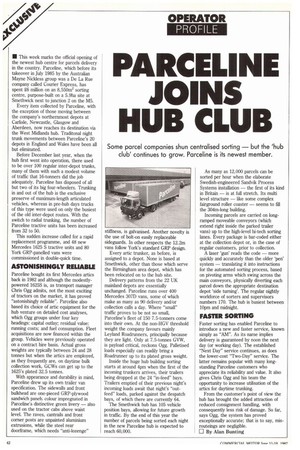PARCELINE JOINS HUB CLUB
Page 44

If you've noticed an error in this article please click here to report it so we can fix it.
• This week marks the official opening of the newest hub centre for parcels delivery in the country. Parceline, which before its takeover in July 1985 by the Australian Mayne Nickless group was a De La Rue company called Courier Express, has spent £6 million on an 8,5500 sorting centre, purpose-built on a 5.9ha site at Smethwick next to junction 2 on the M5.
Every item collected by Parceline, with the exception of those moving between the company's northernmost depots at Carlisle, Newcastle, Glasgow and Aberdeen, now reaches its destination via the West Midlands hub. Traditonal night trunk movements between Parceline's 20 depots in England and Wales have been all but eliminated.
Before December last year, when the hub first went into operation, there used to be over 100 regular inter-depot trunks, many of them with such a modest volume of traffic that 16-tonners did the job adequately. Parceline has disposed of all but two of its big four-wheelers. Trunking in and out of the hub is the exclusive preserve of maximum-length articulated vehicles, whereas in pre-hub clays trucks of this type were used on only the busiest of the old inter-depot routes. With the switch to radial trunking, the number of Parceline tractive units has been increased from 32 to 50.
This sudden increase called for a rapid replacement programme, and 48 new Mercedes 1625 S tractive units and 80 York GRP-panelled vans were commissioned in double-quick time.
ASTONISHINGLY RELIABLE
Parceline bought its first Mercedes artics back in 1982 and although the modestlypowered 1625S is, as transport manager Chris Ogg admits, not the most exciting of tractors on the market, it has proved "astonishingly reliable". Parceline also based its choice of artic equipment for the hub venture on detailed cost analyses, which Ogg groups under four key headings: capital outlay; residual value; running costs; and fuel consumption. Fleet acquisitions are now financed within the group. Vehicles were previously operated on a contract hire basis. Actual gross weights are typically between 24 and 28 tonnes but when the artics are employed, as they frequently are, on daytime bulk collection work, GCWs can get up to the 1625's plated 32.5 tonnes.
With appearance and durability in mind, Parceline drew up its own trailer van specification. The sidewalls and front bulkhead are one-pieced GRP-plywood sandwich panels colour impregnated in Parceline's distinctive green livery — also used on the tractor cabs above waist level. The raves, cantrails and front corner posts are unpainted aluminium extrusions, while the steel rear doorframe, which needs "anti-lozenge" stiffness, is galvanised. Another novelty is the use of bolt-on easily replaceable sideguards. In other respects the 12.2m vans follow York's standard GRP design.
Every artic tninker, as before, is assigned to a depot. None is based at Smethwick, other than those which serve the Birmingham area depot, which has been relocated on to the hub site.
Delivery patterns from the 22 UK mainland depots are essentially unchanged. Parceline runs over 400 Mercedes 307D vans, some of which make as many as 90 delivery and/or collection calls a day. Where "small" traffic proves to be not so small, Parceline's fleet of 150 7.5-tonners come into their own. At the non-HGV threshold weight the company favours mainly Leyland Roadrunners, principally because they are light. Only at 7.5-tonnes GVW, is payload critical, reckons Ogg. Palletised loads especially can readily bring a Roadrunner up to its plated gross weight.
Inside the huge hub building sorting starts at around 4pm when the first of the incoming trunkers arrives, their trailers being dropped at the 24 "in-feed" bays. Trailers emptied of their previous night's incoming loads await that night's "outfeed" loads, parked against the despatch bays, of which there are currently 64.
The Smethwick hub has 105 vehicle position bays, allowing for future growth in traffic. By the end of this year the number of parcels being sorted each night in the new Parceline hub is expected to reach 60,000. As many as 12,000 parcels can be sorted per hour when the elaborate Swedish-engineered Sandvik Process Systems installation — the first of its kind in Britain — is at full stretch. Its multi level structure — like some complex fairground roller coaster — seems to fill the 304m-long building.
Incoming parcels are carried on longramped moveable conveyors (which extend right inside the parked trailer vans) up to the high-level hi-tech sorting lanes. Every package is bar-coded either at the collection depot or, in the case of regular customers, prior to collection.
A laser 'gun' reads the code — more quickly and accurately than the older 'pen' system — translating it into instructions for the automated sorting process, based on pivoting arms which swing across the main conveyors, physically diverting each parcel down the appropriate destination depot 'side turning'. The regular nightly workforce of sorters and supervisors numbers 170. The hub is busiest between 10pm and midnight.
FASTER SORTING
Faster sorting has enabled Parceline to introduce a new and faster service, known simply as "AM". As its name implies delivery is guaranteed by noon the next day (or working day). The established "Next Day" service continues, as does the lower-cost "Two-Day" service. The latter remains popular with many longstanding Parceline customers who appreciate its reliability and value. It also gives Chris Ogg and his team the opportunity to increase utilisation of the artics for daytime trunlcing.
From the customer's point of view the hub has brought the added attraction of reduced consignment handling, with consequently less risk of damage. So far, says Ogg, the system has proved exceptionally accurate; that is to say, misrouteings are negligible.
























































































































